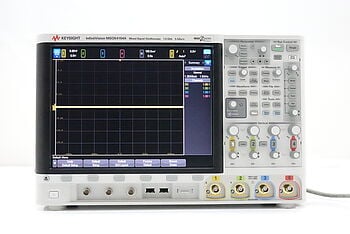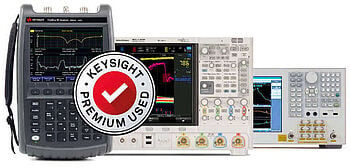- Introduction
- Why Grounding is Important
- How Oscilloscopes Use Ground
- Reference Point: The Foundation for Measurements
- Noise Filtering: The Guardian of Signal Integrity
- Calibration: The Art of Fine-Tuning
- Find Certified Refurbished Oscilloscopes On Sale Now
- Types of Grounding Systems
- Earth Ground
- Signal Ground
- Chassis Ground
- Safety Concerns and Best Practices
- Beware of Voltage Differences
- Use Proper Equipment
- Differential Probes: The Precision Instruments
- Ground Loops and How to Avoid Them
- Common Grounding Mistakes
- Conclusion
- Whenever You’re Ready, Here Are 5 Ways We Can Help You
Have you ever stopped to think about how the frequently disregarded "ground" connection on an oscilloscope is actually a crucial element for accurate measurements, data reliability, and overall safety?
Far from being a simple anchor point, understanding the role and intricacies of ground in oscilloscopes is crucial for professionals in electrical engineering and related fields.
This article delves deep into the concept, unpacking its significance and its impact on your work.
Why Grounding is Important
Grounding serves as a reference point for all voltage measurements. It ensures that the circuit has a point of known voltage, which is usually zero volts. Having a solid ground is vital for:
- Accurate measurements
- Protection against electrical noise
- Safety
| Key Takeaway |
|---|
| Grounding in oscilloscopes serves as the foundational reference point for accurate voltage measurements, noise filtering, and safety precautions. Misunderstanding its roles and types can lead to flawed data and potential hazards, making it an essential aspect to master for anyone working with electrical measurements. |
How Oscilloscopes Use Ground
The role of the ground connection in oscilloscopes is far more multifaceted than it appears at first glance. The ground doesn't just serve as an arbitrary zero point; it is the backbone that supports accurate and reliable measurements.
When you attach the probe's ground clip to the circuit you're testing, you're facilitating a union between the oscilloscope's internal grounding system and the grounding of your circuit.
This seemingly simple act has profound implications for measurement accuracy, noise filtering, and calibration.
Let's dive into these key functions in more detail.
Reference Point: The Foundation for Measurements
In any electrical measurement, you need a reference point to make sense of voltage levels. Grounding the oscilloscope to your circuit establishes this crucial reference.
All the voltages you measure are effectively the potential differences between the point of interest and this ground reference. This is the cornerstone upon which all accurate voltage measurements rest.
- Voltage swing: Knowing your ground level allows you to accurately observe voltage swings, both positive and negative.
- Signal integrity: A stable ground minimizes the chances of measuring spurious signals that could lead to misleading data.
Noise Filtering: The Guardian of Signal Integrity
Electrical noise is the bane of precise measurements. External interferences such as radiated electromagnetic fields or even noise from other components in your circuit can distort your readings. A properly grounded oscilloscope can act like a sieve, filtering out this unwanted noise.
- Shielding: The ground can serve as an electrical shield, absorbing external noise and preventing it from contaminating your data.
- Noise baseline: Grounding allows you to establish a 'noise floor,' making it easier to identify and discount noise during data analysis.
Calibration: The Art of Fine-Tuning
Another less obvious but incredibly important role of ground is in the calibration of the oscilloscope itself. Internally, oscilloscopes have various circuits that need periodic adjustment to ensure accurate measurements.
- Internal circuit balancing: Many oscilloscopes use the ground connection to balance their internal circuits, particularly in dual or multiple-trace oscilloscopes.
- Zero level adjustment: Before taking measurements, oscilloscopes often use the ground level to adjust their internal zero levels. This ensures that any reading starts from an accurate zero point, adding another layer of reliability to your measurements.
Find Certified Refurbished Oscilloscopes On Sale Now
Types of Grounding Systems
In the world of oscilloscopes and electronics, not all grounds are created equal. Various grounding systems serve distinct purposes, from ensuring user safety to enhancing measurement accuracy.
Misunderstanding these types can lead to inaccuracies in data collection and even pose safety risks.
Let's delve deeper into the three primary types of grounding systems: Earth ground, signal ground, and chassis ground.
Earth Ground
Earth ground refers to a physical connection to the earth, usually via a grounding rod driven into the soil. This type of grounding system primarily focuses on safety by providing a path for fault currents to dissipate safely into the earth.
- Fault protection: earth ground acts as a route for electrical surges and fault currents, channeling them away from sensitive components and human operators.
- Static discharge: Connecting to earth ground can eliminate potentially damaging static electricity that may have built up in a circuit.
- Standardization: In most electrical systems, earth ground typically appears as a green wire, making it easily recognizable for proper setup and safety precautions.
Signal Ground
Signal ground serves as the reference point for all signal-level voltages within a circuit or device. It's crucial for obtaining accurate and meaningful measurements.
- Measurement reference: Any voltage level in your circuit will be measured with respect to the signal ground. This is your working baseline.
- Isolation: Unlike earth ground, signal ground may or may not be connected to earth. In some applications, isolating signal ground from earth ground is essential to avoid ground loops or other interference.
- Data integrity: A stable signal ground ensures that the data you collect is free from artificial offsets that can occur due to a fluctuating reference level.
Chassis Ground
Chassis ground is usually connected to the metal casing or chassis of a device. This type of ground serves a dual purpose: shielding the internal electronics from external noise and often providing an additional safety measure by being connected to earth ground.
- Electromagnetic shielding: A metal chassis connected to ground can act as a Faraday cage, shielding internal components from external electromagnetic interference.
- Noise reduction: Chassis ground can serve as a sink for electrical noise, reducing its impact on the device's performance.
- Safety precautions: While not its primary role, chassis ground often connects to earth ground to offer an additional layer of protection against electrical faults.
By understanding the intricacies of these different types of grounding systems, you equip yourself to make more informed decisions in your measurements and system setups, effectively sidestepping common pitfalls and hazards.

Safety Concerns and Best Practices
Safety is paramount when dealing with electrical circuits and equipment like oscilloscopes.
While grounding plays a critical role in achieving accurate measurements, improper grounding can jeopardize both your safety and the integrity of your equipment.
Here's how to ensure you're using grounding correctly, focusing on two primary concerns: voltage differences and the use of proper equipment.
Beware of Voltage Differences
Connecting the oscilloscope's ground clip to a point in the circuit that is not at a true ground potential poses serious risks. Here's why:
- Electric shocks: An improper ground connection can result in stray voltages that could cause electric shocks when you touch other parts of the circuit or equipment.
- Equipment damage: Improperly connecting the ground may introduce unwanted currents into the oscilloscope, posing a risk of harming its delicate internal components.
- Data corruption: Erroneous ground connections can also lead to misleading or completely incorrect data, impacting the validity of your measurements.
Risk Mitigation Strategies
- Double-check: Always use a multimeter to confirm that the point you plan to connect to is actually at ground potential.
- Circuit diagrams: Consult the circuit diagram to identify suitable grounding points, ensuring that you're not mistakenly connecting to a point that merely appears to be a ground.
Use Proper Equipment
Specialized equipment can offer extra layers of safety and accuracy, particularly in complex setups or sensitive measurements.
Isolation Transformer: Your Buffer Zone
An isolation transformer can sever the direct electrical connection between your circuit and earth ground, effectively isolating the two. This prevents ground loops and reduces the risks associated with potential voltage differences.
- Ground loop prevention: By isolating your circuit, the transformer eliminates multiple grounding paths, preventing ground loops from forming.
- Surge protection: Isolation transformers can offer a degree of protection against electrical surges, reducing the risk of equipment damage.
Differential Probes: The Precision Instruments
Differential probes measure the voltage difference between two points in a circuit without making a direct ground connection. This makes them invaluable in situations where establishing a common ground is challenging or risky.
- Flexibility: Differential probes allow you to measure across components, enabling more complex analysis without the need for a common ground.
- Noise reduction: These probes can filter out common-mode noise, providing cleaner data for analysis.
By being aware of voltage differences and equipping yourself with the right tools, you significantly minimize risks. This lets you focus on obtaining the accurate measurements that are vital for your work, while also ensuring the safety of both you and your equipment.
Ground Loops and How to Avoid Them
A ground loop occurs when there's more than one path to ground, creating an unwanted circuit loop. Ground loops can introduce noise and are undesirable for precise measurements.
How to Avoid Ground Loops
- Use only one ground connection point for your setup.
- Utilize ground-breaking resistors.
- Consider using an isolation transformer or opto-isolators.
Common Grounding Mistakes
| Mistake | Consequence | How to Avoid |
|---|---|---|
| Multiple grounding points | Ground loops | Single grounding point |
| Not verifying ground connection | Inaccurate measurements | Always check with a multimeter |
| Using a non-isolated ground | Safety risks | Use isolation transformers or differential probes |
Dive into Keysight's Used Oscilloscope Portfolio
Conclusion
The concept of ground in oscilloscopes is not merely a technicality—it's a cornerstone of accurate signal measurements, effective noise filtering, and above all, safety.
Understanding the roles and types of grounding, along with following best practices, can dramatically enhance the reliability of your measurements and extend the life of your valuable equipment.
Grounding, though often overlooked, is indeed the unsung hero that sets the stage for excellence in all your electrical endeavors.
Now that you understand the critical importance of grounding, it's time to ensure you're equipped with the best tools for the job.
For premium used oscilloscopes, spectrum analyzers, waveform generators, and multimeters, consider shopping at the Keysight Used Equipment Store.
With top-of-the-line gear that meets rigorous quality standards, you can make your precise measurements with the utmost confidence. Step up your game with Keysight—where quality meets affordability.

Whenever You’re Ready, Here Are 5 Ways We Can Help You
- Browse our Premium Used Oscilloscopes.
- Call tech support US: +1 800 829-4444
Press #, then 2. Hours: 7 am – 5 pm MT, Mon– Fri - Talk to our sales support team by clicking the icon (bottom right corner) on every offer page
- Create an account to get price alerts and access to exclusive waitlists.
- Talk to your account manager about your specific needs.

































































































